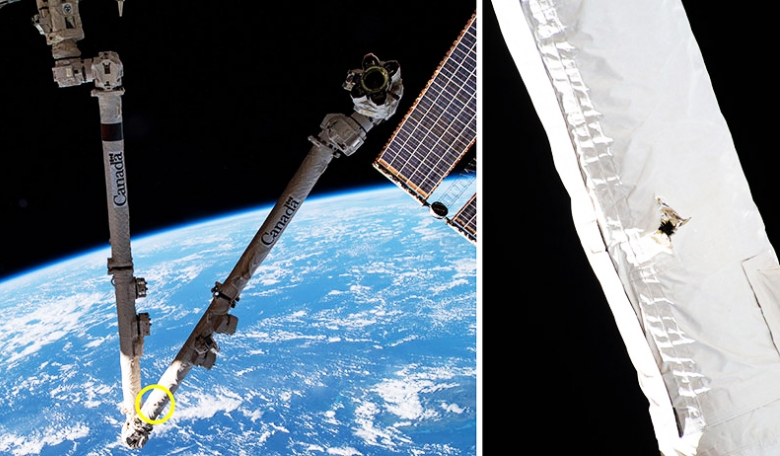The discovery of a small hole in a robotic arm International Space Station (ISS) is a stark reminder of the increasing dangers posed to orbiting spacecraft by space debris. Near-term robotics operations on the Space Station were continuing as normal this week while NASA and the Canadian Space Agency (CSA) officials gather data to conclude an analysis following the impact on Canadarm2.
After identifying the hole during a routine inspection in mid-May, experts from CSA and NASA worked together to take detailed images of the area (see photo) and assess the impact, which occurred on one of Canadarm2's boom segments.
The damage is limited to a small section of the arm boom and thermal blanket where a hole approximately 5 mm in diameter is visible. Results of the ongoing analysis indicate that the arm's performance remains unaffected and Canadarm2 is continuing to work on placing its ‘robotic hand’ (Dextre) to replace a faulty power switchbox.
This latest collision highlights the growing threat posed by orbital debris as the narrow band of space around Earth becomes increasingly crowded with satellites, spent rocket parts and other wayward objects, a problem is magnified by society's dependence on satellite systems for telecommunications, GPS and other everyday services.
It is estimated that there are around 34,000 trackable objects - larger than 5-10 cm in low Earth orbit (LEO) and 30 cm to 1 m in geostationary orbit (GEO) - as well as several thousands to millions of non-trackable debris particles in orbit around the Earth.
“These in-orbit collisions and explosions highlight the need for active intervention and prevention of an uncontrolled increase in the debris population, through both mitigation and remediation of the debris environment,” said Houman Hakima, of Space Strategies Consulting Ltd, Ontario, Canada.
Writing in the Autumn 2020 issue of ROOM, Hakima says: “ In-orbit collisions and explosions highlight the need for active intervention and prevention of an uncontrolled increase in the debris population, through both mitigation and remediation of the debris environment”.
His article, Tackling space debris - a global priority, examined the urgent need to develop strategies for the detection, tracking and removal of space junk.
“These objects pose a serious threat to the operation and safety of critical space assets, such as Global Positioning System (GPS) satellites and the International Space Station (ISS) and its crew,” he added.
“They can also hinder future space activities through a collision cascade effect known as the Kessler syndrome, whereby debris objects collide with each other and disintegrate, resulting in an exponential increase in the debris population and collision likelihood.
“The potential result is that space utilisation in certain orbital regimes could become challenging, if not infeasible, for many generations.”
Editor’s note: the Summer 2021 issue of ROOM Space Journal (published mid-June) will contain a special feature article looking at the development of Canadarm2, its role on the ISS over two decades and what its successor will look like. For your own print or digital copy subscribe now.











